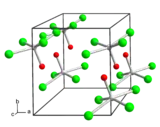 | |
| Identifiers | |
|---|---|
3D model (JSmol) |
|
| ChEBI | |
| ChemSpider | |
| ECHA InfoCard | 100.156.445 |
| EC Number |
|
PubChem CID |
|
| |
| |
| Properties | |
| Cl4MoO | |
| Molar mass | 253.75 g·mol−1 |
| Appearance | dark green solid |
| Melting point | 100–1 °C (212–34 °F; 373–274 K) |
| reacts | |
| Solubility | soluble in benzene and CS2 |
| Hazards | |
| GHS labelling:[1] | |
 | |
| Danger | |
| H314 | |
| P260, P264, P280, P301+P330+P331, P303+P361+P353, P304+P340, P305+P351+P338, P310, P321, P363, P405, P501 | |
Except where otherwise noted, data are given for materials in their standard state (at 25 °C [77 °F], 100 kPa).
Infobox references | |
Molybdenum oxytetrachloride is the inorganic compound with the formula MoOCl4. This thermally unstable, dark green solid is used to prepare other complexes of molybdenum. It adopts a square pyramidal structure of C4v symmetry. As for other Mo(VI) compounds, it is diamagnetic. It decomposes thermally to MoOCl3.
Preparation
It is prepared by treating molybdenum pentachloride with oxygen.[2] It also arises by chlorination of molybdenum trioxide:[3]
- MoO3 + 2 SOCl2 → MoOCl4 + 2 SO2
See also
References
- ↑ "Molybdenum(VI) tetrachloride oxide". pubchem.ncbi.nlm.nih.gov.
- ↑ Mallock, Alan K. (1967). "Molybdenum(VI) Oxide Chloride". Inorganic Syntheses. Inorganic Syntheses. Vol. 10. pp. 54–57. doi:10.1002/9780470132418.ch8. ISBN 9780470132418.
- ↑ Nielson, A. J. (1985). "Tungsten and Molybdenum Tetrachloride Oxides". Inorganic Syntheses. Inorganic Syntheses. Vol. 23. pp. 323–325. doi:10.1002/9780470132548.ch41. ISBN 9780470132548.
This article is issued from Wikipedia. The text is licensed under Creative Commons - Attribution - Sharealike. Additional terms may apply for the media files.